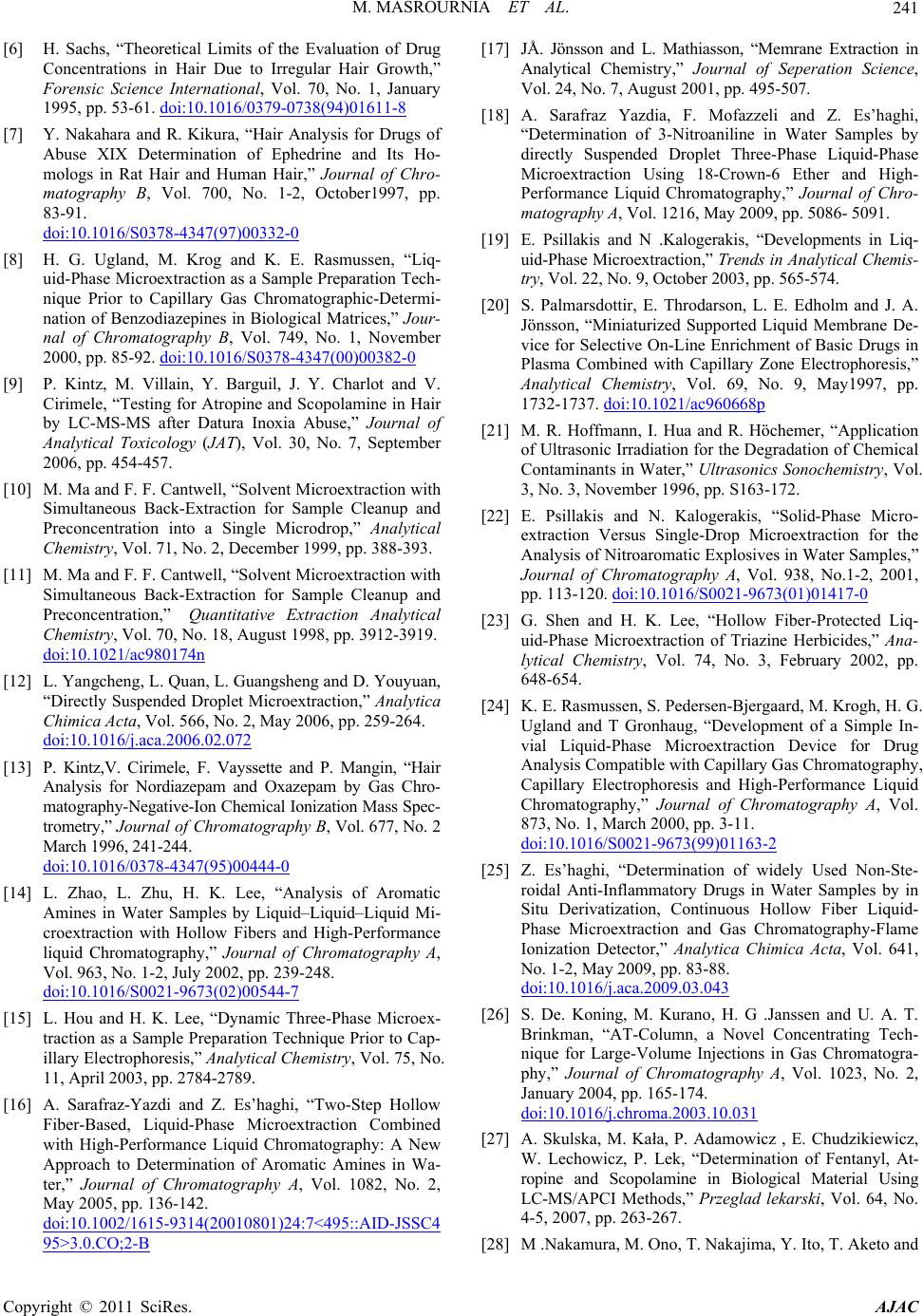
M. MASROURNIA ET AL.241
[6] H. Sachs, “Theoretical Limits of the Evaluation of Drug
Concentrations in Hair Due to Irregular Hair Growth,”
Forensic Science International, Vol. 70, No. 1, January
1995, pp. 53-61. doi:10.1016/0379-0738(94)01611-8
[7] Y. Nakahara and R. Kikura, “Hair Analysis for Drugs of
Abuse XIX Determination of Ephedrine and Its Ho-
mologs in Rat Hair and Human Hair,” Journal of Chro-
matography B, Vol. 700, No. 1-2, October1997, pp.
83-91.
doi:10.1016/S0378-4347(97)00332-0
[8] H. G. Ugland, M. Krog and K. E. Rasmussen, “Liq-
uid-Phase Microextraction as a Sample Preparation Tech-
nique Prior to Capillary Gas Chromatographic-Determi-
nation of Benzodiazepines in Biological Matrices,” Jour-
nal of Chromatography B, Vol. 749, No. 1, November
2000, pp. 85-92. doi:10.1016/S0378-4347(00)00382-0
[9] P. Kintz, M. Villain, Y. Barguil, J. Y. Charlot and V.
Cirimele, “Testing for Atropine and Scopolamine in Hair
by LC-MS-MS after Datura Inoxia Abuse,” Journal of
Analytical Toxicology (JAT), Vol. 30, No. 7, September
2006, pp. 454-457.
[10] M. Ma and F. F. Cantwell, “Solvent Microextraction with
Simultaneous Back-Extraction for Sample Cleanup and
Preconcentration into a Single Microdrop,” Analytical
Chemistry, Vol. 71, No. 2, December 1999, pp. 388-393.
[11] M. Ma and F. F. Cantwell, “Solvent Microextraction with
Simultaneous Back-Extraction for Sample Cleanup and
Preconcentration,” Quantitative Extraction Analytical
Chemistry, Vol. 70, No. 18, August 1998, pp. 3912-3919.
doi:10.1021/ac980174n
[12] L. Yangcheng, L. Quan, L. Guangsheng and D. Youyuan,
“Directly Suspended Droplet Microextraction,” Analytica
Chimica Acta, Vol. 566, No. 2, May 2006, pp. 259-264.
doi:10.1016/j.aca.2006.02.072
[13] P. Kintz,V. Cirimele, F. Vayssette and P. Mangin, “Hair
Analysis for Nordiazepam and Oxazepam by Gas Chro-
matography-Negative-Ion Chemical Ionization Mass Spec-
trometry,” Journal of Chromatography B, Vol. 677, No. 2
March 1996, 241-244.
doi:10.1016/0378-4347(95)00444-0
[14] L. Zhao, L. Zhu, H. K. Lee, “Analysis of Aromatic
Amines in Water Samples by Liquid–Liquid–Liquid Mi-
croextraction with Hollow Fibers and High-Performance
liquid Chromatography,” Journal of Chromatography A,
Vol. 963, No. 1-2, July 2002, pp. 239-248.
doi:10.1016/S0021-9673(02)00544-7
[15] L. Hou and H. K. Lee, “Dynamic Three-Phase Microex-
traction as a Sample Preparation Technique Prior to Cap-
illary Electrophoresis,” Analytical Chemistry, Vol. 75, No.
11, April 2003, pp. 2784-2789.
[16] A. Sarafraz-Yazdi and Z. Es’haghi, “Two-Step Hollow
Fiber-Based, Liquid-Phase Microextraction Combined
with High-Performance Liquid Chromatography: A New
Approach to Determination of Aromatic Amines in Wa-
ter,” Journal of Chromatography A, Vol. 1082, No. 2,
May 2005, pp. 136-142.
doi:10.1002/1615-9314(20010801)24:7<495::AID-JSSC4
95>3.0.CO;2-B
[17] JÅ. Jِönsson and L. Mathiasson, “Memrane Extraction in
Analytical Chemistry,” Journal of Seperation Science,
Vol. 24, No. 7, August 2001, pp. 495-507.
[18] A. Sarafraz Yazdia, F. Mofazzeli and Z. Es’haghi,
“Determination of 3-Nitroaniline in Water Samples by
directly Suspended Droplet Three-Phase Liquid-Phase
Microextraction Using 18-Crown-6 Ether and High-
Performance Liquid Chromatography,” Journal of Chro-
matography A, Vol. 1216, May 2009, pp. 5086- 5091.
[19] E. Psillakis and N .Kalogerakis, “Developments in Liq-
uid-Phase Microextraction,” Trends in Analytical Chemis-
try, Vol. 22, No. 9, October 2003, pp. 565-574.
[20] S. Palmarsdottir, E. Throdarson, L. E. Edholm and J. A.
Jönsson, “Miniaturized Supported Liquid Membrane De-
vice for Selective On-Line Enrichment of Basic Drugs in
Plasma Combined with Capillary Zone Electrophoresis,”
Analytical Chemistry, Vol. 69, No. 9, May1997, pp.
1732-1737. doi:10.1021/ac960668p
[21] M. R. Hoffmann, I. Hua and R. Höchemer, “Application
of Ultrasonic Irradiation for the Degradation of Chemical
Contaminants in Water,” Ultrasonics Sonochemistry, Vol.
3, No. 3, November 1996, pp. S163-172.
[22] E. Psillakis and N. Kalogerakis, “Solid-Phase Micro-
extraction Versus Single-Drop Microextraction for the
Analysis of Nitroaromatic Explosives in Water Samples,”
Journal of Chromatography A, Vol. 938, No.1-2, 2001,
pp. 113-120. doi:10.1016/S0021-9673(01)01417-0
[23] G. Shen and H. K. Lee, “Hollow Fiber-Protected Liq-
uid-Phase Microextraction of Triazine Herbicides,” Ana-
lytical Chemistry, Vol. 74, No. 3, February 2002, pp.
648-654.
[24] K. E. Rasmussen, S. Pedersen-Bjergaard, M. Krogh, H. G.
Ugland and T Gronhaug, “Development of a Simple In-
vial Liquid-Phase Microextraction Device for Drug
Analysis Compatible with Capillary Gas Chromatography,
Capillary Electrophoresis and High-Performance Liquid
Chromatography,” Journal of Chromatography A, Vol.
873, No. 1, March 2000, pp. 3-11.
doi:10.1016/S0021-9673(99)01163-2
[25] Z. Es’haghi, “Determination of widely Used Non-Ste-
roidal Anti-Inflammatory Drugs in Water Samples by in
Situ Derivatization, Continuous Hollow Fiber Liquid-
Phase Microextraction and Gas Chromatography-Flame
Ionization Detector,” Analytica Chimica Acta, Vol. 641,
No. 1-2, May 2009, pp. 83-88.
doi:10.1016/j.aca.2009.03.043
[26] S. De. Koning, M. Kurano, H. G .Janssen and U. A. T.
Brinkman, “AT-Column, a Novel Concentrating Tech-
nique for Large-Volume Injections in Gas Chromatogra-
phy,” Journal of Chromatography A, Vol. 1023, No. 2,
January 2004, pp. 165-174.
doi:10.1016/j.chroma.2003.10.031
[27] A. Skulska, M. Kała, P. Adamowicz , E. Chudzikiewicz,
W. Lechowicz, P. Lek, “Determination of Fentanyl, At-
ropine and Scopolamine in Biological Material Using
LC-MS/APCI Methods,” Przeglad lekarski, Vol. 64, No.
4-5, 2007, pp. 263-267.
[28] M .Nakamura, M. Ono, T. Nakajima, Y. Ito, T. Aketo and
Copyright © 2011 SciRes. AJAC